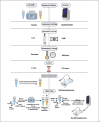Latest Insights on the Diagnostic Approaches and Treatment Strategies of COVID-19
- PMID: 35249006
- PMCID: PMC9148896
- DOI: 10.1159/000522336
Latest Insights on the Diagnostic Approaches and Treatment Strategies of COVID-19
Abstract
Background: COVID-19 has emerged as the most serious pandemic in the 21st century to date. COVID-19 patients may develop various disease symptoms that hinder the accurate clinical diagnosis.
Summary: Routine diagnosis of COVID-19 requires complementary investigations, including computed tomography, immunological assays, and molecular assays like real-time RT-PCR, loop-mediated isothermal amplification, metagenomic next-generation sequencing, and clusters of regularly interspaced short palindromic repeats-based assays. Clinically approved antiviral drugs available for the COVID-19 treatment are very limited. The most common measurements that enhance health condition and patients' viability are conservation fluid management, oxygen therapy, and antibiotics. Several therapeutic options have been developed or repurposed to prevent virus replication and/or modulate the immune response against virus infection. These options include various drugs that affect virus entry and membrane fusion, inhibit polymerase and protease activity, suppress the host pro-inflammatory cytokines, and utilize cell therapy approaches.
Key messages: In this review, we aimed to provide an up-to-date discussion on the current diagnostic options and therapeutic strategies used to control and manage COVID-19 in clinical and point-of-care settings.
Keywords: Coronavirus disease-19; Life cycle; Molecular diagnosis; SARS-CoV-2; Therapeutics.
© 2022 The Author(s). Published by S. Karger AG, Basel.
Conflict of interest statement
The authors have no conflicts of interest to declare.
Figures


Similar articles
-
Development and Validation of a Novel COVID-19 nsp8 One-Tube RT-LAMP-CRISPR Assay for SARS-CoV-2 Diagnosis.Microbiol Spectr. 2022 Dec 21;10(6):e0196222. doi: 10.1128/spectrum.01962-22. Epub 2022 Nov 29. Microbiol Spectr. 2022. PMID: 36445095 Free PMC article.
-
[Repurposing of chlorpromazine in COVID-19 treatment: the reCoVery study].Encephale. 2020 Jun;46(3S):S35-S39. doi: 10.1016/j.encep.2020.04.010. Epub 2020 Apr 29. Encephale. 2020. PMID: 32387014 Free PMC article. French.
-
SARS-CoV-2 causing pneumonia-associated respiratory disorder (COVID-19): diagnostic and proposed therapeutic options.Eur Rev Med Pharmacol Sci. 2020 Apr;24(7):4016-4026. doi: 10.26355/eurrev_202004_20871. Eur Rev Med Pharmacol Sci. 2020. PMID: 32329877 Review.
-
Approaching coronavirus disease 2019: Mechanisms of action of repurposed drugs with potential activity against SARS-CoV-2.Biochem Pharmacol. 2020 Oct;180:114169. doi: 10.1016/j.bcp.2020.114169. Epub 2020 Jul 23. Biochem Pharmacol. 2020. PMID: 32710969 Free PMC article. Review.
-
Current status of antivirals and druggable targets of SARS CoV-2 and other human pathogenic coronaviruses.Drug Resist Updat. 2020 Dec;53:100721. doi: 10.1016/j.drup.2020.100721. Epub 2020 Aug 26. Drug Resist Updat. 2020. PMID: 33132205 Free PMC article. Review.
References
-
- Cascella M, Rajnik M, Cuomo A, Dulebohn SC, Di Napoli R. StatPearls. StatPearls Publishing; 2020. Features, evaluation and treatment coronavirus (COVID-19) [Internet] - PubMed
Publication types
MeSH terms
Substances
LinkOut - more resources
Full Text Sources
Medical
Miscellaneous

